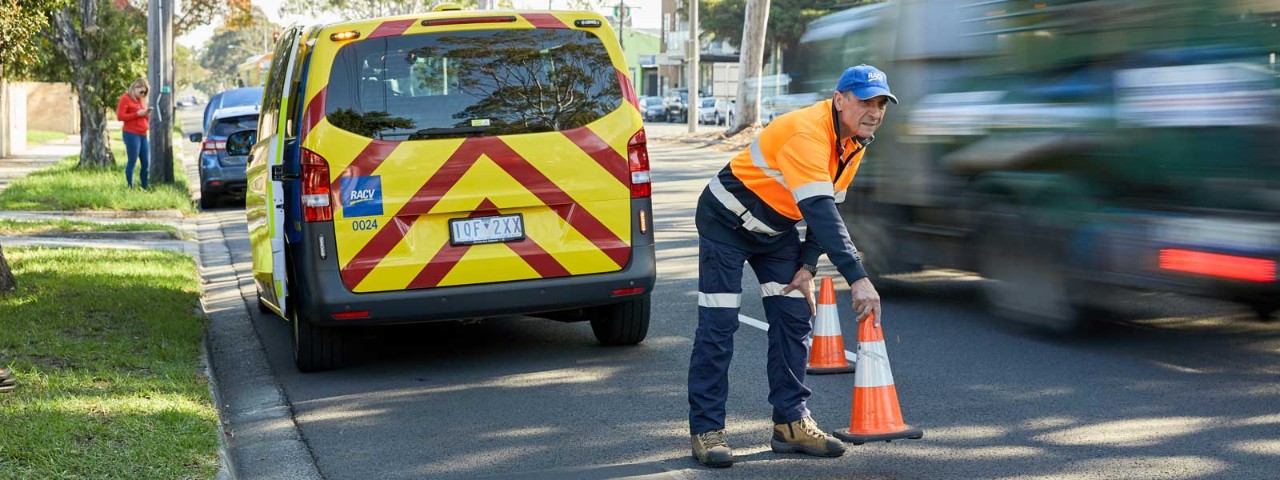Having the brakes fail in your car can be a scary experience. Here's what to do if your car brakes stop working, to help you stay safe and in control on the road.
RACV's successful campaign to safeguard roadside workers and customers

RACV has successfully campaigned for the Victorian government to change a road rule to help protect emergency roadside assistance workers, tow truck drivers, and their customers.
RACV has welcomed the Victorian Government’s announcement on 30 April 2025 that Road Rule 79A will be expanded to protect emergency roadside workers, tow truck drivers, and their customers.
RACV General Manager of Automotive Services Makarla Cole said the amendment addresses a safety issue in the Victorian road rules and aligns Victoria with other Australian states.
Are you up to date with your road rules?
- Victoria’s new drink driving laws and the penalties for breaking them
- The most misunderstood road rules in Victoria
- Road safety around schools – what everyone needs to know
- Understanding mobile phone road rules in Australia
- Understanding inbuilt device and car screen laws in Victoria
- The written and unwritten pedestrian road rules in Victoria
What the road rule extension means for drivers
“Since 2017, drivers on Victorian roads have had to slow down to 40km/h per hour when passing emergency services vehicles at the side of the road,” said Ms Cole.
“For the past two years, RACV has called on the Victorian Government to include roadside assistance vans, such as RACV patrol vans, and tow trucks in this rule.
“From July 1, 2025, Road Rule 79A will be extended to include accident towing, breakdown towing, roadside assistance, Peninsula Link Incident Response, Eastlink Incident Response and Transurban Incident Response vehicles.
“Currently, Road Rule 79A only applies to police vehicles, emergency vehicles, enforcement vehicles, and VicRoads Incident Response Service vehicles.
“RACV is pleased with Minister Melissa Horne's announcement that Victorians will soon slow down when passing any incident response vehicle, including RACV patrol vans.
“Victoria's emergency roadside workers and tow truck drivers are often the first and only responders to an incident or breakdown and are exposed to the same risks to other responders, such as police and paramedics.
“I am sure every driver who has needed the help of an emergency roadside assistance worker or tow truck driver will be pleased to know that the Victorian Government is now protecting these essential responders in their workplace, and their customers.”
Victoria's slow down rule to protect roadside workers in line with other states
By including tow truck drivers and emergency roadside workers in Road Rule 79A, Victoria is now in line with other Australian jurisdictions.
Queensland, Western Australia, New South Wales,Tasmania, and South Australia also have a slow down rule to ensure the safety of roadside workers and those they assist.
- Queensland: Drivers are required to slow down and move over into another lane (if possible) when passing roadside assistance vehicles with flashing lights.
- Western Australia: Drivers must slow to 40km/h when approaching stationary roadside assistance vehicles that are displaying flashing lights at an incident.
- New South Wales: The 'Slow Down, Move Over' rule mandates drivers to slow down to 40km per hour when passing stationary roadside assistance vehicles with flashing yellow lights in speed limits of 80km per hour or less, and must give way to any person on foot associated with the assistance vehicles. On roads with a speed limit of 90km or more, drivers must slow to a reasonable safe speed.
- Tasmania: Drivers must safely slow down to 40km/h when passing roadside assistance vehicles displaying flashing lights. On roads over 80km/h, drivers must slow down as safely as they can.
- South Australia: From 19 May 2025, drivers must slow down to 25 km/h when passing a stationary breakdown service vehicle with flashing amber lights.


